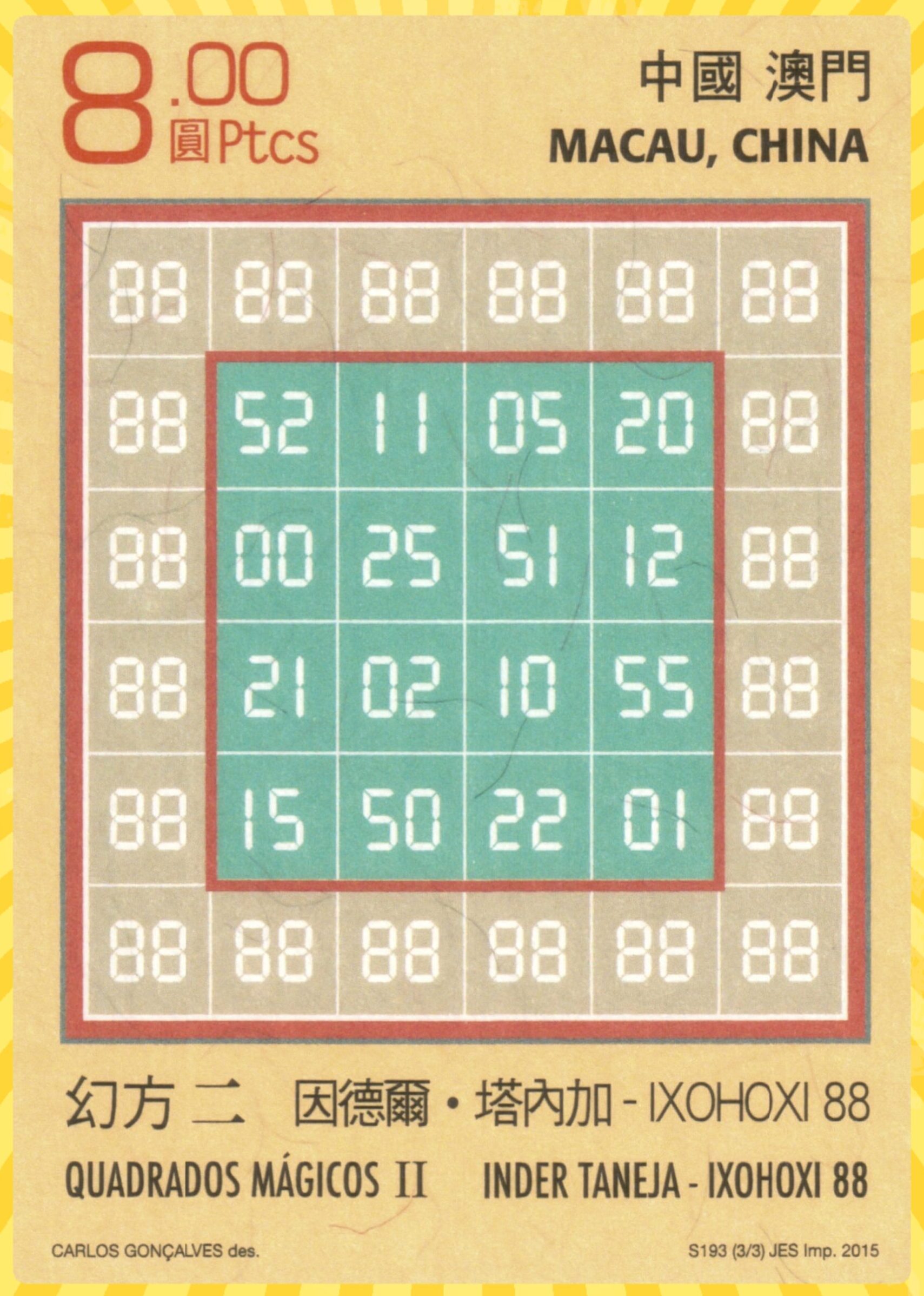There are many ways of representing magic squares with palindromic type entries. Also, we can write magic squares in the composite forms based on pair of Latin squares. This paper works with magic squares of order 3 to 6. By upside-down, we understand than by making 180o it remains same. When the magic square is of both type, i.e., upside-down and mirror looking, we call it an universal magic square. By mirror looking we understand that putting in front of mirror, still we see the image as a magic square. In case of mirror looking, writing as digitais fonts, 2 becomes 5 and 5 as 2. In case of upside-down, 6 becomes 9 and 9 as 6.
Follow the following link to see this work online.
- Inder J. Taneja, Universal and Upside-Down Magic Squares of Orders 3 to 6, Zenodo, November 05, 2024, pp. 1-61, https://doi.org/10.5281/zenodo.14041149.
For more work up to order 25 see the reference list given at the end of this work.
Magic Squares of Order 3
a) 2-Digits Cell Entries:
Example 1. The Digits (1,6,9)
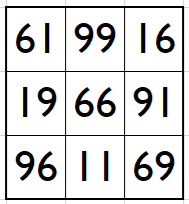
It is upside-down semi-magic square of order 3 with 3-digits (1,6,9). The magic sum is S3×3(1,6,9):=176. This magic square becomes becomes semi-magic in case of mirror looking.
Example 2. The Digits (2,5,8)
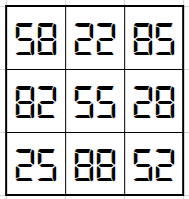
It is universal magic square of order 3 with 3-digits (2,5,8). The magic sum is S3×3(2,5,8):=165. This magic square becomes becomes semi-magic in case of mirror looking.
b) 3-Digits Cell Entries
Example 3. The Digits (1,6,9)
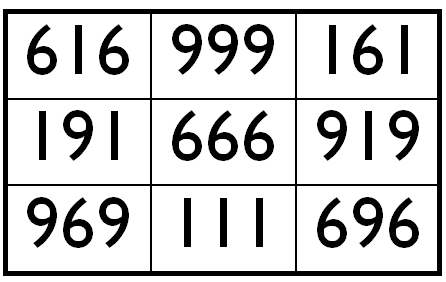
It is upside-down semi-magic square of order 3 with 3-digits (1,6,9). In this case, the entries are palindromes. The magic sum is S3×3(1,6,9):=1776.
Example 4. The Digits (2,5,8)
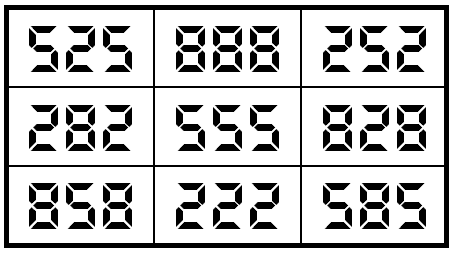
It is universal magic square of order 3 with 3-digits (2,5,8). The magic sum is S3×3(2,5,8):=1665. In this case, the entries are palindromes. This magic square becomes becomes semi-magic in case of mirror looking.
c) 4-Digits Cell Entries:
Example 5. The Digits (1,8)
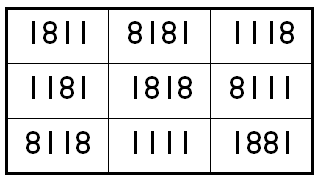
It is universal semi-magic square with semi-magic sum: S3×3(1,8):=11110.
Example 6. The Digits (2,5)

It is universal semi-magic square with semi-magic sum: S3×3(2,5):=9999. This sum refer to original and upside-down versions. For mirror looking version the semi-magic sum is S3×3(2,5):=13332.
Example 7. The Digits (6,9)

It is upside-down semi-magic square with semi-magic sum: S3×3(6,9):=23634.
Magic Squares of Order 4
a) 2-Digits Cell Entries:
Example 8. The Digits (1,6,8,9)
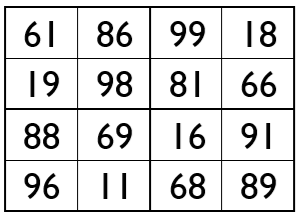
It is upside-down magic square of order 4 with 4-digits (1,6,8,9). The magic sum is S4×4(1,6,8,9):=264.
Example 9. The Digits (0,1,2,5)
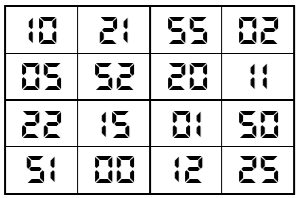
It is universal magic square of order 4 with 4-digits (0,1,2,5). The magic sum is S4×4(0,1,2,5):=88.
It is well-known author’s stamp published at Macau – China – 2015. See below:
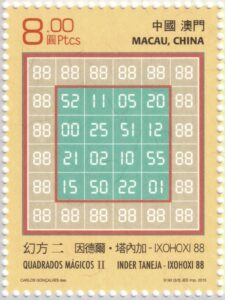
b) 3-Digits Cell Entries:
Example 10. The Digits (1,6,8,9)
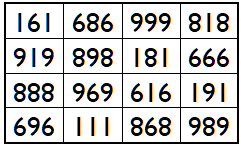
It is upside-down magic square of order 4 with 4-digits (1,6,8,9). In this case, the entries are palindromes. The magic sum is S4×4(1,6,8,9):=2664.
Example 11. The Digits (1,2,5,8)
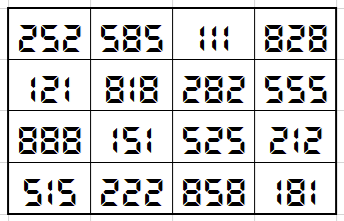
It is universal magic square of order 4 with 4-digits (1,2,5,8). In this case, the entries are palindromes. The magic sum is S4×4(1,2,5,8):=1776.
c) 4-Digits Cell Entries:
Example 12. The Digits (1,8)
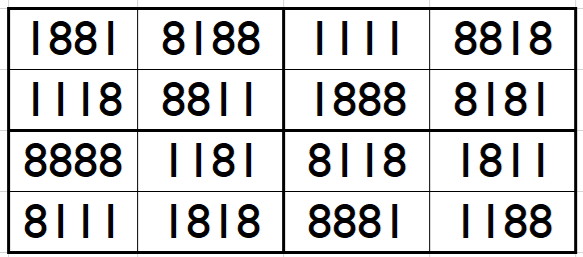
It is pandiagonal universal magic square of order 4 with 2-digits (1,8). The magic sum is S4×4(1,8):=19998.
Example 13. The Digits (2,5)

It is pandiagonal universal magic square of order 4 with 2-digits (2,5). The magic sum is S4×4(2,5):=15554.
Example 14. The Digits (6,9)
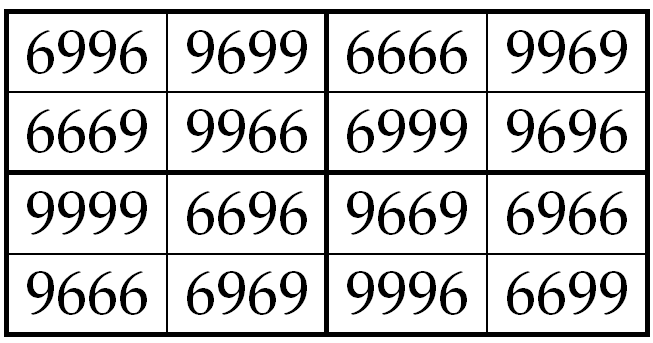
It is pandiagonal upside-down magic square of order 4 with 2-digits (6,9). The magic sum is S4×4(6,9):=33330.
d) 7-Digits Cell Entries:
Example 15. The Digits (1,8)

It is pandiagonal universal magic square of order 4 with 2-digits (1,8). The entries are palindromes. The magic sum is S4×4(1,8):=19999998.
Example 16. The Digits (2, 5)

It is pandiagonal universal magic square of order 4 with 2-digits (2,5). The entries are palindromes. The magic sum is S4×4(2,5):=15555554.
Example 17. The Digits (6, 9)

It is pandiagonal upside-down magic square of order 4 with 2-digits (6,9). The entries are palindromes. The magic sum is S4×4(6,9):=33333330.
Magic Squares of Order 5
a) 5-Digits Cell Entries
Example 18. The Digits (0,1,6,8,9)
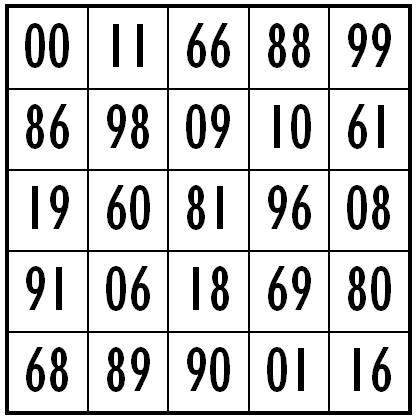
It is pandiagonal upside-down magic square of order 5 with 5-digits (0,1,6,8,9). The magic sum is S5×5(0,1,6,8,9):=264.
Example 19. The Digits (2,5,6,8,9)

It is pandiagonal upside-down magic square of order 5 with 5-digits (2,5,6,8,9). The magic sum is S5×5(2,5,6,8,9):=330.
Example 20. The Digits (0,1,2,5,8)
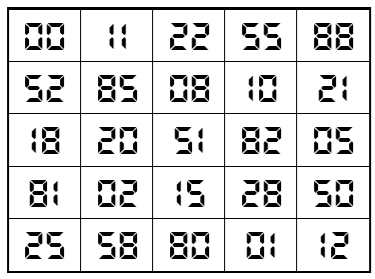
It is pandiagonal universal magic square of order 5 with 5-digits (0,1,2,5,8). The magic sum is S5×5(0,1,2,5,8):=176.
b) 3-Digits Cell Entries
Example 21. The Digit (1,2,5,6,9)

It is pandiagonal upside-down magic square of order 5 with 5-digits (1,2,5,6,9). In this case the entries are palindromes. The magic sum is S5×5(1,2,5,6,9):=2553.
Example 22. The Digits (0,1,2,5,8)
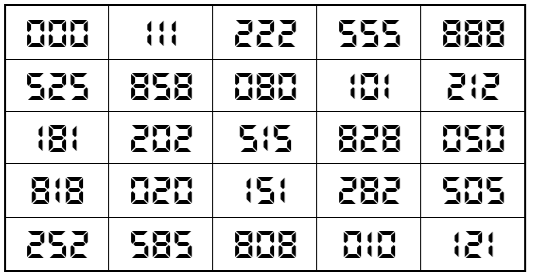
It is pandiagonal universal magic square of order 5 with 5-digits (0,1,2,5,8). In this case the entries are palindromes. The magic sum is S5×5(0,1,2,5,8):=1776.
c) 4-Digits Cell Entries
Example 23. The Digits (1,6,9)
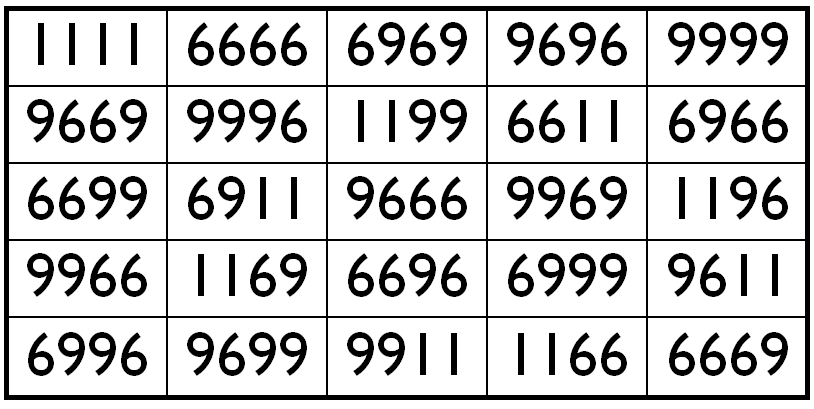
It is pandiagonal upside-down magic square of order 5 with 3-digits (1,6,9). The magic sum is S5×5(1,6,9):=34441.
Example 24. The Digits (6,8,9)
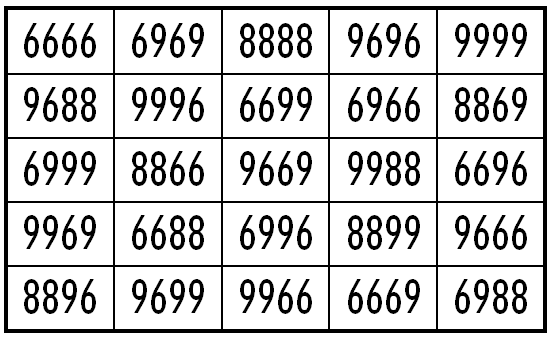
It is pandiagonal upside-down magic square of order 5 with 3-digits (6,8,9). The magic sum is S5×5(6,8,9):=42218.
Example 25. The Digits (2,5,8)
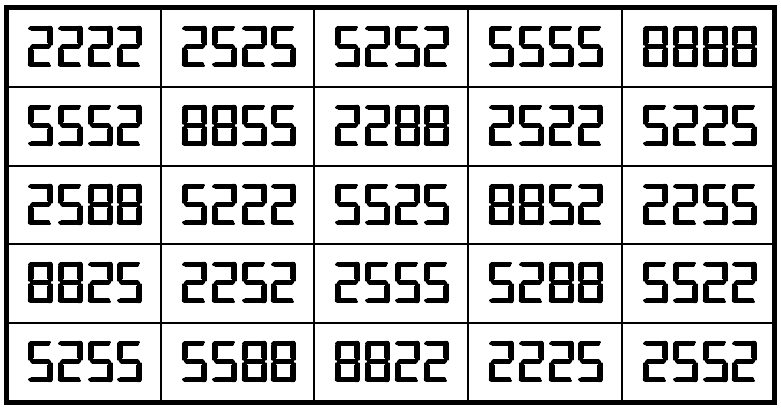
It is pandiagonal universal magic square of order 5 with 3-digits (2,5,8). The magic sum is S5×5(2,5,8):=24442.
b) 6-Digits Cell Entries
Example 26. The Digits (1,8)

It is pandiagonal universal magic square of order 5 with 2-digits (1,8). The magic sum is S5×5(1,8):=2958956.
Example 27. The Digits (2,5)
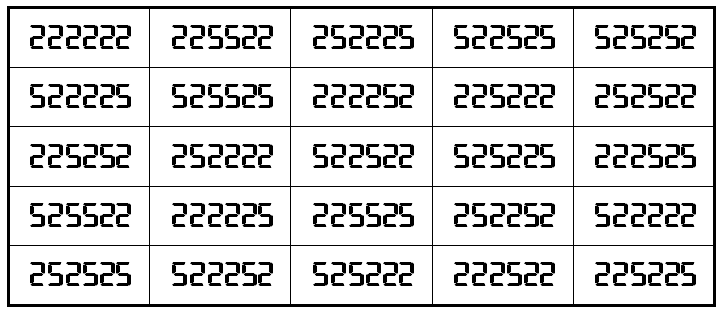
It is pandiagonal universal magic square of order 5 with 2-digits (1,8). The magic sum of original and upside versions are same, i.e., S5×5(2,5):=1747746. The magic sum of mirror looking version is S5×5(2,5):=2141139. It is pandiagonal in all the three cases.
Example 27. The Digits (6,9)

It is pandiagonal universal magic square of order 5 with 2-digits (6,9). The magic sum is S5×5(6,9):=2958956. The magic sum of upside-down version is different and is given by S5×5(6,9):=4363359.
Magic Squares of Order 6
a) 4-Digits Cell Entries:
Example 28. The Digits (2,5,8)
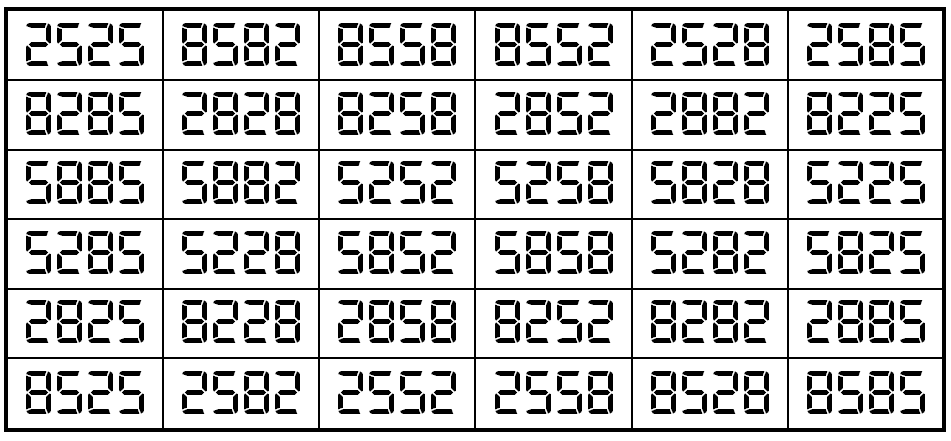
It is upside-down magic square of order 5 with 3-digits (6,8,9). The magic sum is S6×6(2,5,8):=33330. This magic square is only upside-down because its mirror looking image is no more a magic square.
a) 6-Digits Cell Entries:
Example 29. The Digits (1,8)
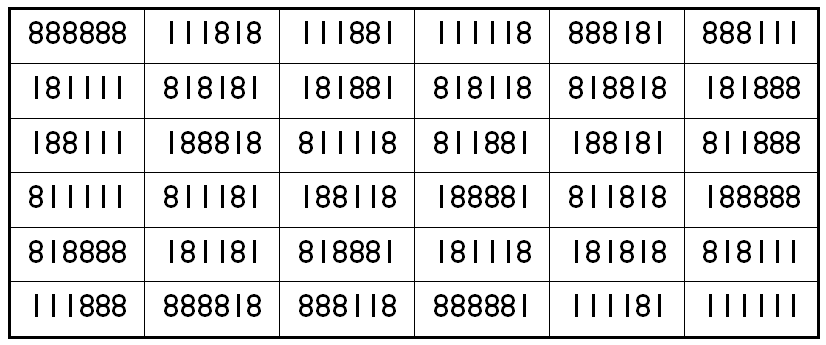
It is universal magic square of order 6 in 2-digits 1 and 8. The magic sums is S6×6(1,8):=2999997.
Example 30. The Digits (2,5)
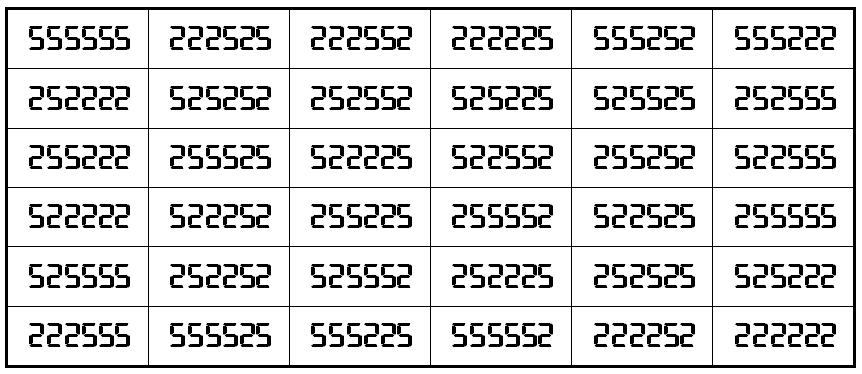
It is universal magic square of order 6 in 2-digits 2 and 5. The magic sum in all the three cases is same, i.e., S6×6(2,5):=2333331.
Example 31. The Digits (6,9)
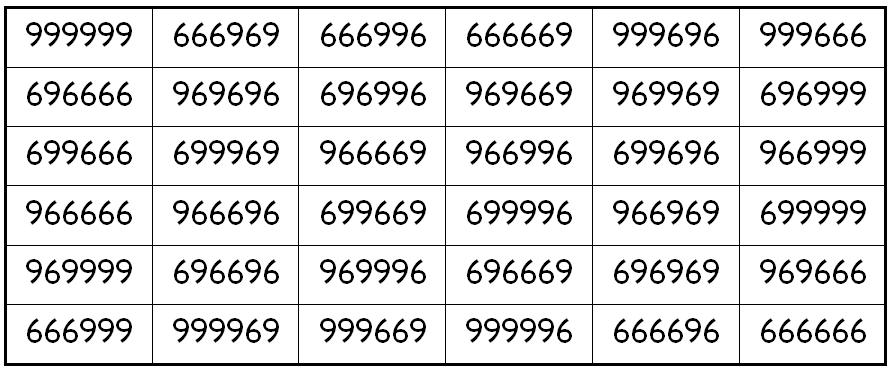
It is universal magic square of order 6 in 2-digits 6 and 9. The magic sums is S6×6(6,9):=4999995.
References
- Inder J. Taneja, Universal and Upside-Down Magic Squares of Orders 3 to 6, Zenodo, November 05, 2024, pp. 1-61, https://doi.org/10.5281/zenodo.14041149
- Inder J. Taneja, Universal and Upside-Down Magic Squares of Orders 7 to 10, Zenodo, November 05, 2024, pp. 1-120, https://doi.org/10.5281/zenodo.14041164
- Inder J. Taneja, Universal and Upside-Down Magic Squares of Orders 11 to 15, Zenodo, October 06, 2024, pp. 1-141, https://doi.org/10.5281/zenodo.14041168
- Inder J. Taneja, Universal and Upside-Down Magic Squares of Order 16, Zenodo, October 16, 2024, pp. 1-28, https://doi.org/10.5281/zenodo.13942620
- Inder J. Taneja, Universal and Upside-Down Magic Squares of Order 20, Zenodo, October 20, 2024, pp. 1-56, https://doi.org/10.5281/zenodo.13958700.
- Inder J. Taneja, Universal and Upside-Down Magic Squares of Order 21, Zenodo, October 23, 2024, pp. 1-49, https://doi.org/10.5281/zenodo.13982859
- Inder J. Taneja, Universal and Upside-Down Magic Squares of Order 24, Zenodo, October 29, 2024, pp. 1-82, https://doi.org/10.5281/zenodo.14004788
- Inder J. Taneja, Universal and Upside-Down Magic and Bimagic Squares of Order 25, Zenodo, October 30, 2024, pp. 1-53, https://doi.org/10.5281/zenodo.14014851.
